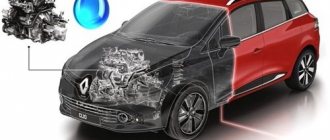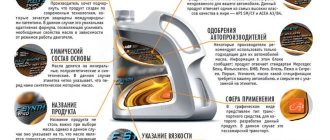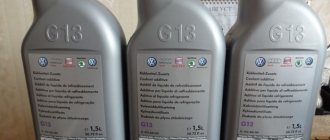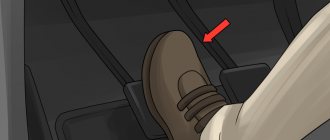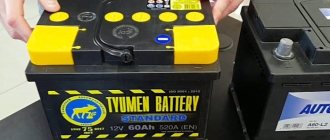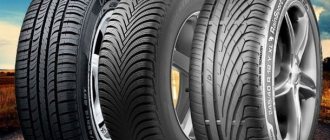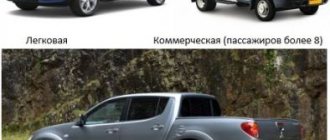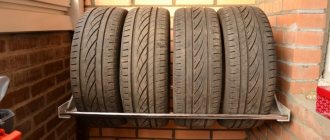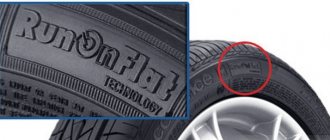How many seasons does Velcro winter tires last?
Despite the declared resource, it is important to constantly monitor the condition of the rubber.
The main indicator is the jumpers on the surface of the tires, the wear of which indicates the end of their service life. Initially, you should focus on the date of manufacture of the product, which is usually applied to the side surface of the tread.
It should be remembered that the performance characteristics of a tire are noticeably reduced during long-term storage without the use of special protective equipment. It is better to give preference to products with the latest release date.
The result of improper storage can be multiple microcracks, which during operation will lead to rapid wear and destruction of the tire material.
The need to replace winter tires is quite easy to determine visually. For example, if more than half of the total number of studs is lost, the tread is worn by 30%, it is definitely necessary to change the wheel.
Thus, the following signs indicate tire wear:
- loss of 60% of spines;
- pattern wear more than 30%;
- tread depth less than 4 mm;
- cuts, deformations;
- bumps from blows.
Rating of the best winter studded tires Continental
When studding, spikes are installed from the leading manufacturer of these products, Tikka Spikes Oy from Finland, part of Continental.
The unique technology of introducing studs into the tread ensures their long service life.
The special composition of the compound allows the use of rubber at any winter temperatures.
Continental IceContact 3
Description of the tire. The German company produces a wide range of tires of this model.
They are suitable for passenger cars of various classes and SUVs.
The original symmetrical directional pattern with a large number of contact zones ensures excellent vehicle handling and traction on snow, ice, and asphalt.
When moving, the rubber makes minimal noise.
This is due to the use of polyurethane foam bonded to the inside of the tire material.
The ContiSeal technology used in production helps to tighten punctures (up to 5 mm) using a viscous component placed inside the tire.
Spikes. Installed on the tread according to an original pattern, reminiscent of an animal's paw.
They are soldered in during the vulcanization process, heating up the thermal adhesive material with which the spike is coated.
In the model, the company uses a new, rubberized type of spike.
Index range. Speed index: T (190 km/h), load index: 75 – 111 (387 – 1090).
Dimension. Manufacturers produce a large model line of Continental IceContact 3 tires, ranging from a diameter of 14 to 22 inches.
The profile width can vary in the range of 155 – 255 mm, height: 35 – 75%.
Pros of Continental IceContact 3
- They grip the road well, including ice.
- Reliable braking.
- Attractive tread pattern design.
- Excellent handling.
Cons of the Continental IceContact 3
- Despite the “unique technology”, the studs fly out after a short run.
Regarding car studs falling out, car owners say that after Continental admitted the mistake and abandoned rubberized studs, their falling out stopped.
Continental IceContact 2
Description of the tire. The tires use innovative developments from German designers.
Thanks to them, drivers have lower fuel costs when using tires, due to reduced rolling resistance.
The original asymmetrical tread pattern improves traction characteristics.
Spikes. In accordance with European laws on studding rubber, the Germans have reduced the aggressive impact of studs on the road surface, but increased their number, now there are 18 rows.
The maximum number on a large size tread is 190 pieces.
Multifaceted studs with carbide tips reliably grip the ice crust and hold the car when turning.
Index range. The Continental IceContact 2 T speed index allows a car wearing this tire to travel at a maximum speed of 190 km/h.
Load index per tire: 75 – 116 (387 – 1250 kg).
Dimension. Such tires can be placed on passenger cars, crossovers, and SUVs with wheels with a diameter of 13 - 21 inches.
Depending on the standard size, the tread width varies from 155 to 285 mm, height: from 35 to 75%.
Pros of Continental IceContact 2
- Comfortable, silent movement.
- Reliable spikes, do not fly out.
- Maintains performance over a wide temperature range.
- Easy balancing.
Cons of Continental IceContact 2
- Uncertain handling on dry asphalt.
- Slightly overpriced.
- Doesn't behave well enough in a rut.
Owners recommend that inexperienced motorists run in tires in a gentle manner. Then there will be no problems with the spikes flying out, and the noise during movement will be reduced.
Winter studded tires: service life
Let us note once again that the service life of winter tires is somewhat shorter than the same period for summer tires. Although the tires are visually almost identical, the composition of winter and summer tires is very different. Without going into too much detail, summer tires are hard, while winter tires are softer and more flexible, causing them to wear out harder and faster.
First of all, if you purchase new or used tires, you need to determine the manufacturer and know the release date of the tire in order to understand how many such tires are still available. When purchasing winter studded tires, these aspects need to be given special attention.
Please note, in order to determine how long winter tires last, it is worth dividing the tires into expensive branded ones and cheap ones. Branded products from well-known global manufacturers are wear-resistant. If the tire is stored correctly, correctly selected for a specific car, and installed on a rim taking into account the characteristics of the tire, then the service life of winter studded tires or Velcro can be 5 years or more.
However, cheap tires (Chinese or budget domestic) under the same conditions may not last for a couple of seasons. The fact is that expensive tires contain patented components that allow the rubber not to age and retain its properties for a long time. Cheap tires usually do not have such additives or their quantity is insignificant, which leads to cracking of the tire, loss of elasticity, etc.
Winter tire service life
Let's return to studded winter tires. Often, manufacturers determine that the service life of winter studded tires is 7 years or about 50-60 thousand km. The same goes for Velcro. However, in reality, such an indicator can be achieved if a tire that is “fresh” by the date of manufacture is operated in almost ideal conditions.
If the car is used aggressively (sharp starts, active braking), the car often drives at high speed on dry asphalt, winter tires are used at positive temperatures (above +8 degrees Celsius), in this case the studs themselves fly out and the tire wears out quickly.
Shelf life of winter tires
In addition to the service life of the rubber, you also need to pay attention to the expiration dates. These are slightly different concepts that need to be distinguished. Simply put, the service life is actually the resource of the tire during operation and depends on many factors, while the shelf life depends on the production date and storage conditions.
To make it clear, even if the tire is not in use, but is simply stored new in a warehouse, the rubber still ages and will eventually become unusable. As a rule, if tires have been in storage for several years (4-7 years or more), you should not expect full compliance with all declared performance characteristics.
It turns out that the tires are completely new in terms of wear, but the tires that are old by the date of manufacture will wear out more and faster when driving after installation on the car, they may be noisier, and they lose elasticity.
Otherwise, winter tires, which contain many more components to maintain elasticity, quickly dry out and crack. This means that if the storage conditions are fully met, the tire will retain its properties after 2-3 years, while a gross violation of the conditions may mean that after a couple of years the tire is not suitable for use.
To find out the date of manufacture of tires, you need to pay attention to the markings. The date of manufacture is marked on the side surface as a four-digit number (after 2000). However, you need to remember that before 2000 the designations were slightly different. You can study relevant material on this topic.
Winter tire service life
Yes, under favorable operating conditions on good roads, the service life of summer tires can reach 10 years. These tires use harder rubber, so they are quite capable of safely rolling off their entire service life. But with winter tires the situation is completely different.
In practice, the service life of winter car tires is shorter than summer tires. This is explained by the fact that the rubber of winter tires has a different composition, it is softer, so its service life is significantly shorter.
In addition, the service life of winter studded tires differs from tires that do not have studs. Typically, manufacturers claim that winter studded tires and Velcro can be used for 7 years or 50–60 thousand km. But this is only if you manage to find ideal conditions.
What do we mean by ideal conditions for using winter tires? This is a stable temperature of about zero degrees, constant pressure in the wheels of the value specified by the manufacturer, moving over an even layer of snow or ice at low speed. It is precisely these conditions that studded tires and Velcro are designed for.
We recommend
“The expiration date of car tires: how to find out” Read more
It is clear that not a single driver is able to ensure this. And if you add to this an aggressive driving style, and even on dry asphalt at elevated temperatures (+8 °C or more), then you should not count on the seven-year service life of winter studded tires. They will wear out much earlier, and before that the spikes will fly off.
How long can winter studded tires last? Here, a lot depends on operating conditions, tire age, mileage. From practice we can say that high-quality wheels will serve well for 5 years or 50 thousand km. That is, you can expect to use a set of tires for 5 years at moderate rates of operation (10 thousand km per season).
Experts on service life
Depending on the manufacturer, tires can withstand from two to six seasons. At the same time, European brands are characterized by greater durability than Chinese or Russian ones. It depends on the technological process and the quality of materials. The main thing when purchasing is a careful inspection and assessment of the condition of the tread and its release date.
Manufacturers count the warranty period of their products from the date of manufacture of the tire. Most of them offer a five-year warranty.
In addition, manufacturing countries indicate the service life of their products, which is expressed in mileage figures:
- European protectors – 50,000-60,000 km;
- Russian – 20,000-40,000 km;
- Chinese - 50,000-80,000 km.
Thus, different tires should last at least two seasons.
According to experts, winter tires lose their performance after just four years of use. After this they “glaze over”.
Experts from the German automobile club ADAC reasonably believe that after two years the cost of tires should decrease significantly. The domestic market offers products whose shelf life does not exceed 3-4 years.
Factors affecting the service life of car tires
How long exactly can a car tire last? This depends on many circumstances, which means that in each case the period is determined individually. In general, the following factors need to be taken into account:
1.
Type of vehicle and its carrying capacity
. The service life of truck tires will be no less than that of passenger tires, but for them the tires have a different load rating. The more weight a car can carry, the stronger its wheels should be.
Depending on the permissible load index, mileage standards are established for certain tires:
- tires for passenger cars with a carrying capacity of up to 2 tons are designed for a mileage of 45 thousand km;
- tires for trucks with a carrying capacity of 2 to 4 tons are designed for a mileage of 60 thousand km;
- tires for trucks with a carrying capacity of more than 4 tons are designed for a mileage of 65–70 thousand km.
2. Tire dimensions
. If the tires have a low profile, then on uneven and gravelly roads they will hit the wheel, therefore, their service life will be shorter. Wide tires wear out more due to increased friction when cornering. This factor increases in winter.
3. Driver's driving style
. Aggressive driving - sudden starting and braking - significantly reduces tire life.
4. Quality of the road surface
. This point needs no comment.
5. Mileage and intensity of use of the car
.
6. Rubber quality
. This parameter is very important because the service life of tires from different manufacturers differs significantly. Cheap Chinese tires will last a maximum of a couple of seasons, while products from well-known brands can be safely used for about 7 years. Therefore, when purchasing, you need to pay due attention to the choice of manufacturer. You also need to be able to distinguish original products from fakes.
7. Presence of mechanical defects
. Damage occurs in different ways: the tire can be cut, deformed as a result of emergency braking or an accident, etc.
Tire expiration date - Debunking the myths
Consumer disputes over the age of tires have not subsided for several seasons. Buyers are worried that the warranty period for tires is limited to 5-6 years according to GOST, and after this period the rubber becomes unusable.
Is this really so, read this article.
Tire shelf life
Manufacturers of most brands set a shelf life of 5 years for their products and a service life of 5 years.
.
The shelf life of tires is the period during which they retain their performance when stored correctly.
Completion of this period does not mean that the tires have become unusable
. A shelf life of 5 years is given by manufacturers because, by law, they cannot set a shelf life higher than the service life. Tires that have been stored for more than 5 years cannot be called damaged or defective; their technical characteristics may be slightly reduced. American researchers claim that the storage period for “shoes” must be at least 10 years. Experts from Germany are confident that it cannot exceed 6 years.
Tire expiration date
The shelf life of tires is the warranty period during which the manufacturer is responsible for the quality and condition of the tire if it was used for its intended purpose without violating the operating rules.
According to Russian legislation (GOST 5513, GOST 4754-97), the service life of tires is 5 years from the date of manufacture.
How to find out the manufacturing date of tires?
You can find out the age of tires using a special DOT code. Tires produced after 2000 in the DOT code contain two pairs of numbers, where the first pair indicates the week number of the year, and the second - the year. Earlier tires before 2000 have 3 numbers, where the first two digits are the week number, and the last one is the year (see the decoding in the photo).
Determination of the average shelf life of a tire according to GOST and operating conditions.
— The symbol ZR denotes tires for high-speed cars. They are recommended to be used at speeds above 240 km/h. for up to 6 years
— Tires with the H symbol are used at a maximum speed of 210 km/h. within 5 years.
— The S sign symbolizes the maximum permissible speed of 180 km/h. and operational life of 4-5 years.
Shelf life according to manufacturers estimates
Most tire manufacturers do not agree that tires have a 5-year shelf life.
Each company has its own established opinion on this matter. We analyzed several of them and the information they posted on their official websites. The French tire manufacturer Michelin has become famous for its active fight against the idea that tires are rapidly aging as a perishable product. Her Tires Are Not Bananas awareness campaign created a lot of buzz in the automotive community. According to the representative office, several test trials were carried out in Saudi Arabia, South Korea and Germany. As a result of the tests, no difference was found between new tires and tires stored for 3 years. They were tested for various characteristics such as rolling resistance, strength at high speeds, etc. Tires with a one-year service life were approximately equal in performance to 10-year-old unused tires.
Michelin draws the attention of car owners to the fact that tires are not a perishable product, their shelf life is not as important as their service life, which begins from the date the tires are installed on the wheels. It is from this moment that the tire is subjected to all tests: pressure, temperature changes, wear, contact with uneven and sharp surfaces, etc.
Continental
On the Russian official website of Continental we found the following information on the expiration dates of tires.
What manufacturers say
Russian GOST 4754-97 states that pneumatic rubber can be used for 5 years from the date of manufacture. And off-road tires last up to 10 years.
It is not safe to use tires older than 8 years. Over a fairly long period of time, a tire loses its elasticity, causing it to have poorer grip on the road.
Pneumatic tires look like this
You can check the age of tires on the side of the product. Here the manufacturer places a special marking, where the first and second digits indicate the week, and the next two indicate the year the product was created.
The indicators indicated on paper or the rubber itself do not always correspond to reality. Manufacturers themselves recommend timely technical inspection and checking the level of wear.
The time frame may also depend on the type of tire. There are:
- studded wheels;
- Velcro tires.
The service life also depends on the country in which the rubber manufacturing company is located:
- Tires from European countries are capable of rolling from 50,000 to 70,000 km without losing their consumer properties.
- Domestic products are slightly less durable - from 20,000 to 40,000 km.
- Chinese tires will last approximately 50,000 – 80,000 km.
On average, for new tires this figure consists of six seasons of operation. The service life of Velcro winter tires is longer than that of studded models, but it is not suitable for regions with harsh climates.
Studded tires are the best solution for the winter
Factors affecting tire wear
The wear of car tires is influenced by many factors : country of manufacture, mileage, operating and storage conditions. Let's list the main ones.
Storage method
stored in a cool, dark and dry place. Too high temperatures, humidity and sun are detrimental to rubber products. Tires on rims should be stacked for storage, and empty tires should be stacked vertically next to each other.
Tire pressure
Check the tire pressure regularly - low levels negatively affect the service life. Also, do not overinflate your tires; when using a pump, be sure to check the result with a pressure gauge. For the winter period, the pressure is 0.2 bar higher.
A tire pressure reduced by 2 bar increases the braking distance by 1.5 times.
You can find out the correct values from the following table.
Rating of the best winter studless tires Continental
Cool Chili technology is used in the production of friction rubber.
When producing tires, an increased amount of silicon dioxide and resins are used.
This composition of the compound maintains the elasticity of the material even in severe frosts.
Continental ContiWinterContact TS 860
Description of the tire. These tires are manufactured for installation on class A, B, C, D cars, as well as crossovers and SUVs.
When developing the model, Continental focused on increasing the level of safety.
The unique composition of the compound makes it possible to improve braking efficiency and increase acceleration and grip performance.
A new development is used in the symmetrical directional pattern: zones have appeared that promote better vehicle maneuverability on a snowy road.
A large drainage network allows you to quickly remove the water film formed when the wheel interacts with the road.
This improves the quality of grip on any road surface in winter.
Index range. Various standard sizes have the following speed indices: T, H, V, W (up to 190, 210, 240, 270 km/h), loads: 75 – 109 (387 – 1030 kg).
Dimension. ContiWinterContact TS 860 tires are installed on wheels with a diameter of 13 - 21 inches, a tread width of 155 - 315 mm, and a profile height of 30 - 80%.
Pros of the Continental ContiWinterContact TS 860
- Excellent behavior on roads with any surface.
- The softness of the tires is maintained in frosty weather.
- Good wear resistance.
- Excellent handling.
- Confident braking.
Cons of the Continental ContiWinterContact TS 860
- They are noisy on wet asphalt.
- The sidewall is weak.
Continental ContiViking Contact 7
Description of the tire. The rubber mixture of the model contains rapeseed oil, which gives greater strength to the product.
It also, together with silica, makes the compound soft, remaining elastic at low temperatures outside.
Diamond-shaped blocks of the central tread block help the car maintain directional stability at various speeds.
The wavy shape of the lamellas covering the contact areas and their edges enhance the quality of adhesion to the road surface.
At the bottom of the grooves for removing water there are jumpers connecting the tread blocks to each other.
This design makes control more efficient and predictable.
Index range. Speed index: T (190 km/h), load index: 72 – 116 (355 – 1250 kg per tire).
Dimension. The tires are suitable for passenger cars and crossovers with a rim diameter of 14 - 21 inches and a tread width of 125 - 195 mm.
Sidewall height for different sizes: 16 to 70% of the width.
Pros of the Continental ContiVikingContact 7
- Comfortable control.
- Minimal noise when driving.
- Good maneuverability.
- Remains soft at -40°C.
- It brakes excellently on asphalt and snow, but a little worse on ice.
Cons of the Continental ContiVikingContact 7
- It has a slight roll - the driver should be careful and keep his distance.
Continental ContiWinterContact TS 860S
Description of the tire. In the production of this model of friction tires, the proprietary Continental Run Flat technology is used, as indicated by the letter S in the rubber marking.
When there is a puncture and subsequent release of pressure in the tire, the hole is filled with rubber-based filler.
The use of this technology allows the driver to get to the nearest tire service center while moving at low speed.
The model also uses Cool Chili technology, which improves the performance characteristics of the rubber.
The increased content of silicate components enhances the adhesion properties of the compound and helps improve vehicle dynamics.
Index range. The model's speed index varies depending on the tire diameter: H, V, W, Y (210, 240, 270, 300 km/h).
The load index is: 89 – 116 (580 – 1250 kg).
Dimension. The company produces a wide range of standard sizes ContiWinterContact TS 860S: 16 – 22 inches.
The profile width can vary from 175 to 315 mm, height: from 30 to 60%.
Pros of the Continental ContiWinterContact TS 860S
- Good grip on the road, including when cornering.
- They drain snow porridge and water perfectly.
- Clear car controls.
- Confident braking in all conditions.
Cons of the Continental ContiWinterContact TS 860S
- Overpriced.
Owners unanimously recommend purchasing tires of this model.
Continental ContiVikingContact 6 SUV
Description of the tire. This model of friction tires for off-road vehicles is designed for use in countries with difficult climatic conditions: Scandinavia, Russia.
The tread has an asymmetrical directional pattern, allowing the rubber to exhibit excellent grip in various weather conditions.
The shoulder areas are equipped with wide contact patches with grooves extending onto the sides.
This ensures good cross-country ability for the SUV on snowy surfaces and in off-road conditions.
Distributing the load across the entire width of the contact area makes the wear of the compound uniform and increases the service life of the rubber.
The rubber compound is made using Nordic Soft technology, which allows the tires to maintain their performance at extremely low temperatures.
Index range. Speed index: T (190 km/h), load index: 96 – 116 (710 – 1250 kg).
Dimension. The rubber is suitable for wheels 16 - 21 inches with a profile width of 215 - 275 mm, height 40 - 75%.
Pros of the Continental ContiVikingContact 6 SUV
- Quiet tires.
- Confident braking.
- Durable side parts.
- Good handling in all conditions.
- Excellent directional stability.
Cons of the Continental ContiVikingContact 6 SUV
- When driving on ice at speed, drifts are possible.
- Not wear resistant enough.
Continental ContiWinterContact TS 810 Sport
Description of the tire. Such tires are installed on sports cars and passenger cars capable of showing excellent dynamic characteristics.
In addition to good grip on the road in winter conditions, the tires have excellent acceleration and braking performance.
The central tread block with a symmetrical directional pattern is responsible for reliable directional stability.
Contact checkers have two types of lamellas.
The slots of the stiffener improve traction on any type of track.
The lamellas located in the shoulder areas provide better vehicle handling.
The presence of wide and deep drainage channels allows the driver to avoid the effect of aquaplaning.
The unique production technology of a compound with polymer additives provides excellent dynamic properties of rubber and reliable braking.
Index range. Tires have speed index T, H, V, W (190, 210, 240, 270 km/h), load index is: 82 – 107 (475 – 975 kg).
Dimension. Tires are placed on wheels with a diameter of 15 - 20 inches with a tread width of 175 - 295 mm, a profile height of 30 - 65%.
Pros of the Continental ContiWinterContact TS 810 Sport
- Low noise level.
- Good handling on wet and dry asphalt.
- Increased wear resistance.
- Excellent tires for the city.
- Predictable behavior.
Cons of the Continental ContiWinterContact TS 810 Sport
- Uncertain behavior on ice and slush.
Winter and summer tires - what are the differences?
Manufacturers create certain types of rubber for each weather season. For winter - winter tires, for summer - summer tires. And their characteristics are different. The least of the problems is that in the summer the tread pattern quickly wears off from winter tires. Therefore, logically speaking, you should follow the order of changing seasonal tires. What happens if you ride on Velcro in the summer? On wet roads, in fog or in rain, car controllability will be problematic. The car will skid from side to side. This increases the risk of an accident. And the risk of paying a fine. Not to mention the fact that the rubber itself quickly becomes unusable.
Velcro rubber is winter tires and is suitable for use only at sub-zero temperatures.
Some motorists believe that if there are no spikes on the friction rubber, then the Velcro is just seasonal rubber. And it can be used at any time of the year. But actually it is not. The technical characteristics indicate that Velcro is winter tires, with all the attendant circumstances. It is suitable for use only at sub-zero temperatures. While the car is moving, the rubber heats up, and in the summer it can deform the tires. Which in turn can lead to an accident. How to distinguish Velcro from summer tires? First of all, summer tires are rougher and harder. It is made of hard material. The blocks in the picture are large; wear indicators are placed in the main tread grooves. In winter, it has poor traction. The pattern quickly becomes clogged with snow, and the braking distance increases significantly. It is silent on summer roads.
Advantages of Continental winter tires
Despite the fact that Germany does not have such a harsh climate as Russia, Continental studded tires are very popular in our country.
This is due to the fact that the brand constantly introduces new technological solutions and thinks through various technological aspects. The characteristics of studs and friction rubber from the company presented have much in common. Thus, the manufacturer was the first to use a siping system, which began to divide the tread into two separate parts. Thanks to this system, optimal grip on roads with different surfaces is ensured.
Also, all tires are equipped with many drainage channels, which, together with the tread, serve as a good way to remove moisture and independently clean snow and water from the contact patch. Even if the road surface has a large amount of water, the tires are cleaned as efficiently as possible, so no sliding effect occurs during movement.
Continental winter studded tires include an optimal ratio of rubber, silica and components containing silicon. Thanks to this, the service life of car tires increases, and its softness and elasticity are maintained even at very low temperatures.
Depending on the tire model, studs can have completely different shapes and configurations. For example, the Continental4x4 IceContact is interesting because the studs in it are arranged in 12 rows, and they are installed using a special floating technology. This is a model designed for SUVs, which makes it possible to cope with almost any kind of extreme roads and sporty driving style.
Another stud option is the ContinentalContiIceContact BD. These tires are an interesting option for all-wheel drive vehicles and business class vehicles. Despite the fact that the model was developed in 2010, it still remains popular among car owners thanks to the Brilliant Plus stud manufacturing technology.
Firstly, such a stud has a carbide insert, which provides good dynamics and effective braking. Secondly, the grip edges are long enough to provide maximum interaction with the tread.
Features of studded tires
It is believed that studded tires provide high-quality grip on the road surface. At the same time, the braking distance is significantly reduced, which is especially important in winter. But current winters are not always rich in snow. In such conditions, studded tires are not the best option. The studs may fall out, damaging the integrity of the tire.
- excellent grip;
- good directional stability;
- short braking distance;
- low probability of drifts.
- high noise;
- presence of steering wheel vibration;
- increased fuel consumption;
- loss of thorns.
What is the expiration date of rubber?
The law establishes the standard period for wheel tires - 5 years. However, there is no strict ban on their further use, so many people sell, buy, and continue to drive on tires that have long since crossed this threshold.
Indeed, global companies producing rubber tires provide a guarantee for their products from 6 to 10 years. Therefore, the service life comes to the fore, when tires are able to maintain their properties and meet safety requirements.
IMPORTANT! The expiration date is calculated from the moment of production, not the start of use.
At the winter
Rubber for the cold season is softer, has a specific composition and service life. Its peculiarity is Velcro or studs, which are designed to improve traction and speed up braking.
The average service life indicated by manufacturers is 7 years under ideal operating and maintenance conditions. It is clear that given the Russian climate and roads it is impossible to ensure this, so using the same tires is permissible for a maximum of 3-4 seasons. It should be noted that Velcro will last a little longer.
At the summer
Summer tires vary by category. The composition, purpose, and wear resistance depend on it. It is logical to assume that tires for driving at high speeds over 200 km/h marked H, ZR are subject to greater loads and wear out faster.
For the safety of the car owner, it is strongly recommended to replace such tires after a maximum of 6 years. The same principle applies to large vehicles and trailers. They last a long time, have a low annual mileage, the treads may look decent without external damage, but this is not evidence of their reliability.
The permissible period of use of regular summer tires can be obtained from the manufacturer. Often, it is stated as a guarantee. In any case, using tires for more than 5 years is accompanied by a certain risk.
Therefore, it is especially dangerous to buy used tires. It is unknown how often it was used, maintained, stored, or whether it was properly cared for. Therefore, it is impossible to say exactly how long it will serve its new owner.
What is the service life of tires: winter tires
So, if we summarize the information received, the service life of winter studded tires or Velcro can be determined taking into account the features discussed above.
If we talk about the service life of winter studded tires, in this case the most important indicators will be the age of the rubber, operating conditions and mileage.
As a rule, such tires from well-known brands (taking into account that no more than 3 years have passed from the date of production of the tires, the rubber was stored correctly and was installed on the disk taking into account all the requirements) last about 50 thousand kilometers on snow and ice.
It is important to understand that even if the conditions are optimal, the tires are in excellent condition, and the mileage on them is minimal, such tires will still lose their properties in 8-10 years.
Visually, rubber aging is indicated by a change in color (from black to gray), the appearance of cracks, delamination, etc. In this case, the tires need to be changed regardless of the condition of the tread, studs, sidewall, etc.
As practice shows, on average, good quality winter tires last about 50 thousand km or 5 years. It turns out that the service life of rubber is about 5 years with relatively short mileages of up to 10 thousand km. per season.
By the way, the service life of winter tires is separately indicated in the traffic regulations. According to traffic regulations, tires must be changed taking into account wear, that is, when the tread depth is less than 4 mm. Winter tires must be marked (snowflake symbol, M+S, etc.).

